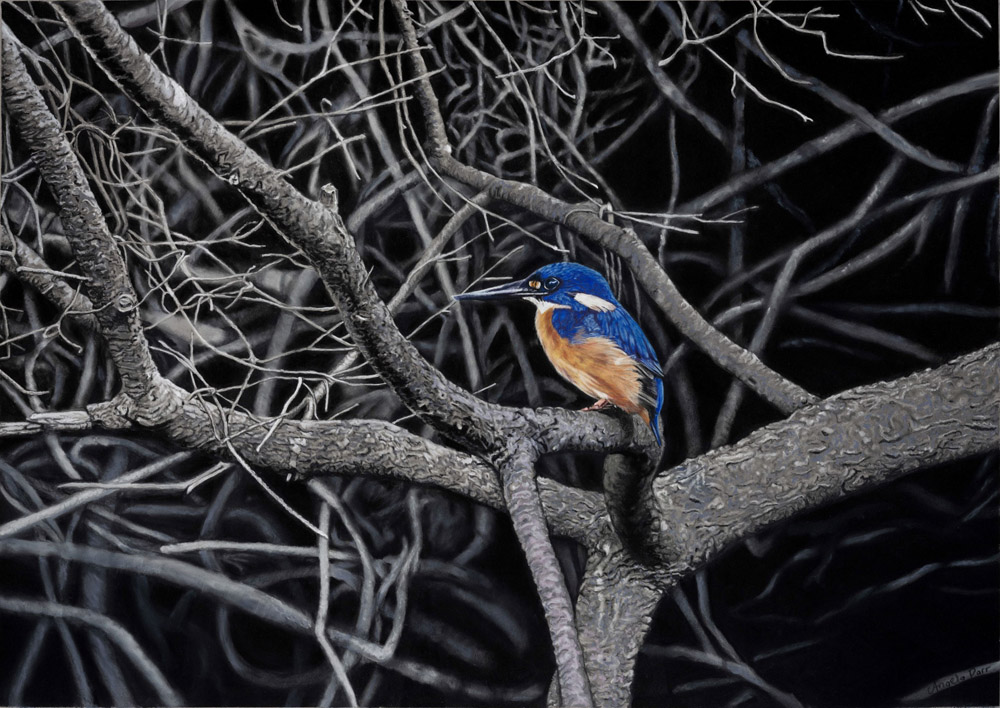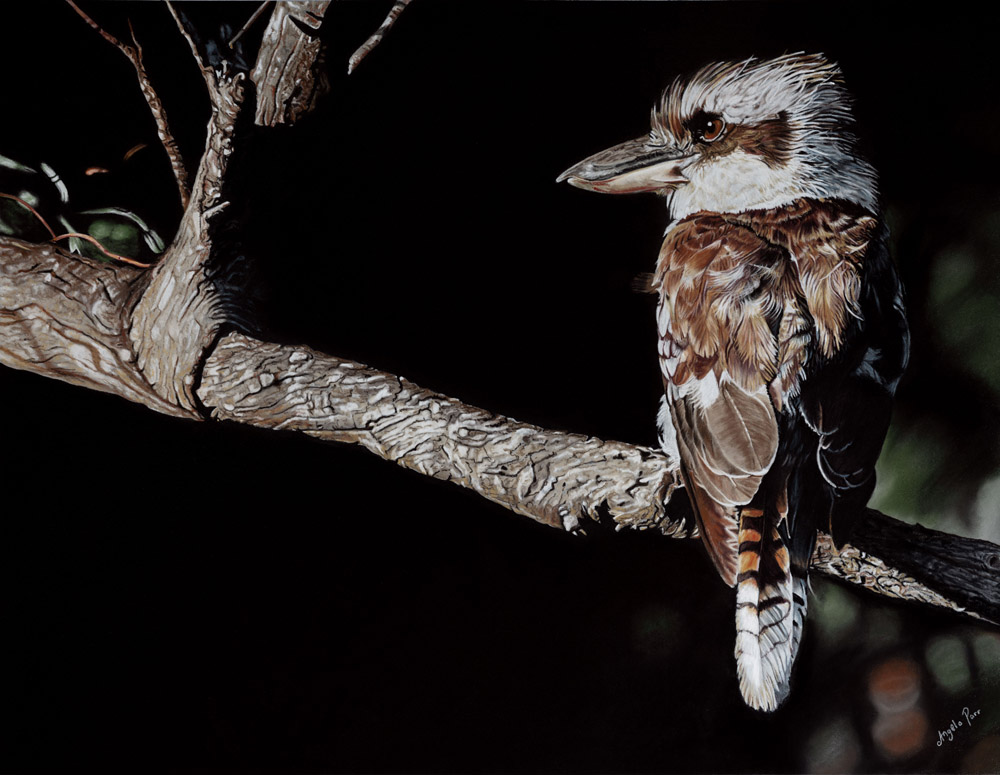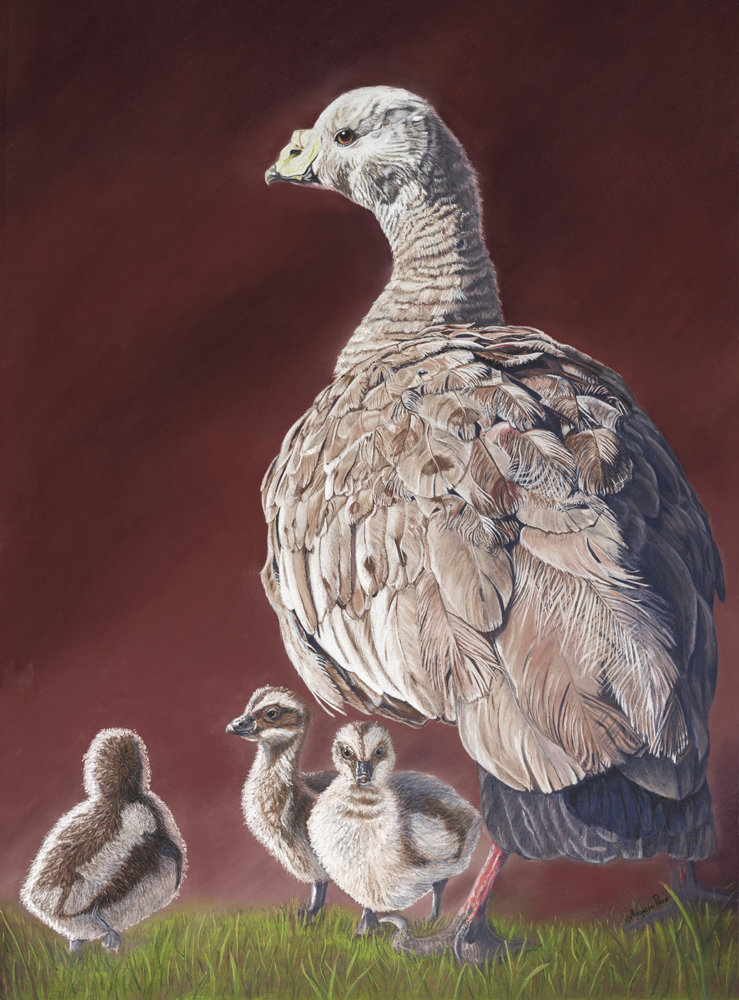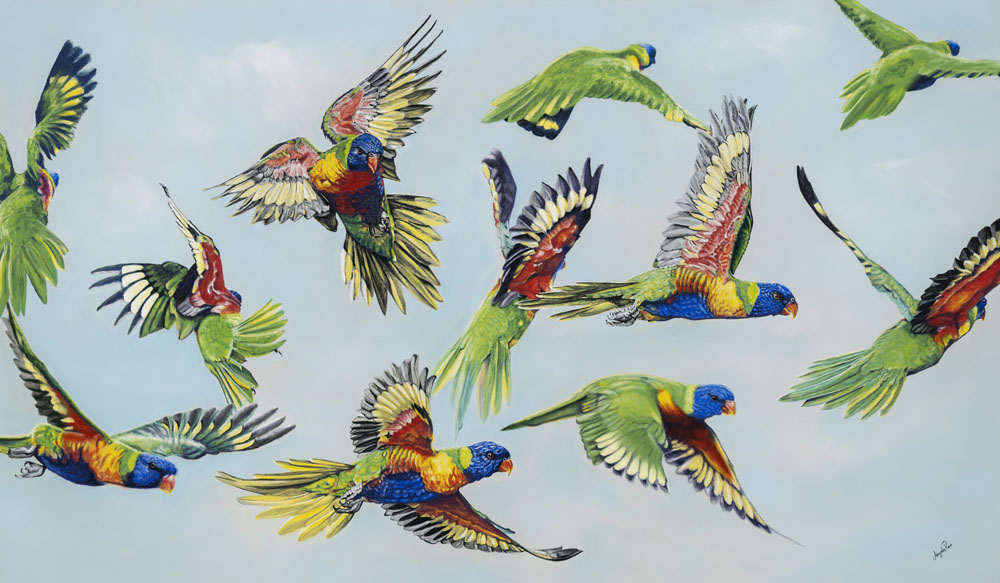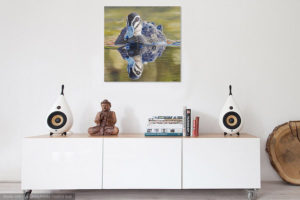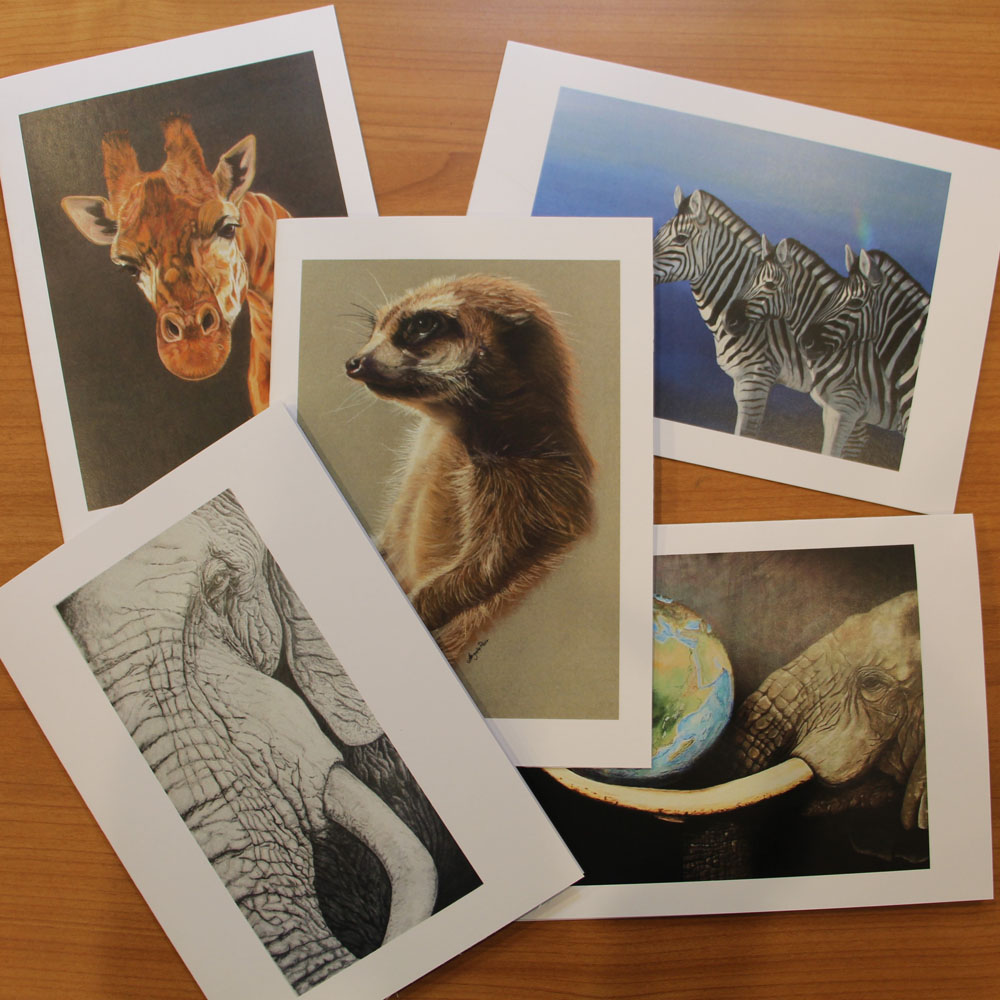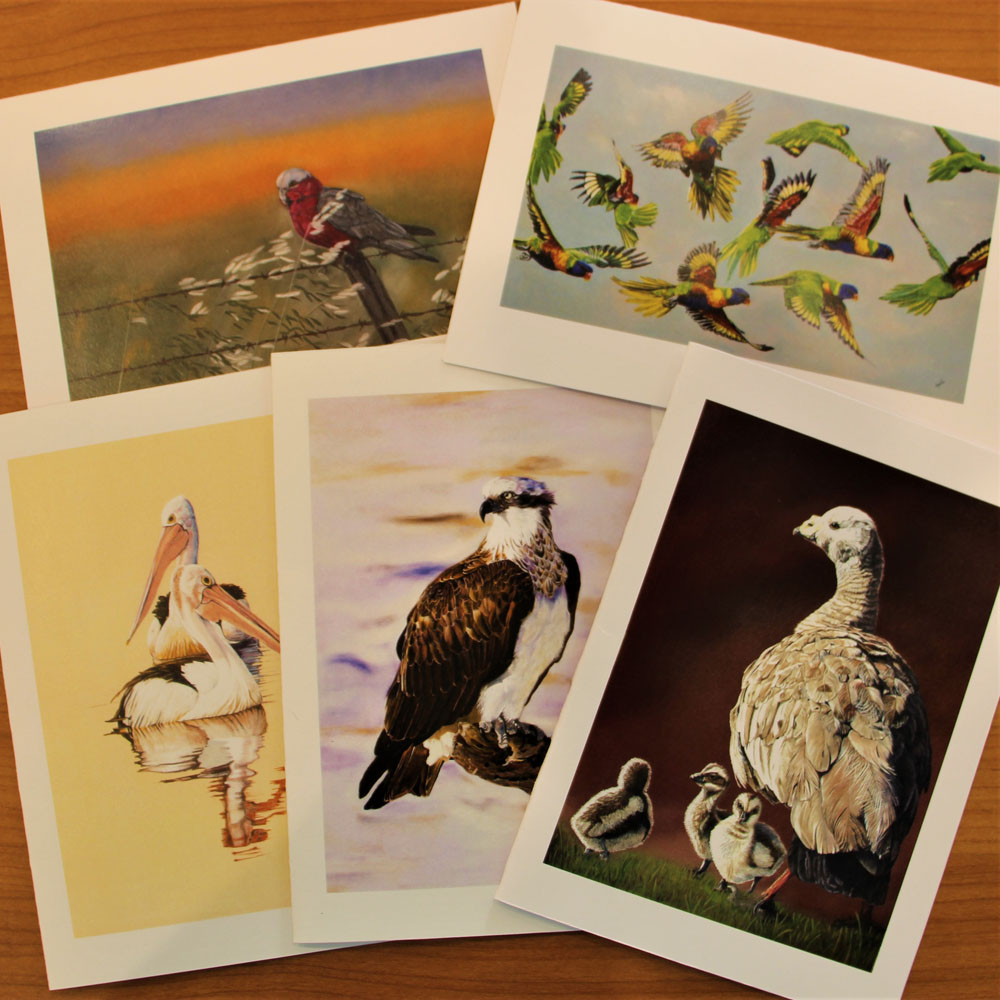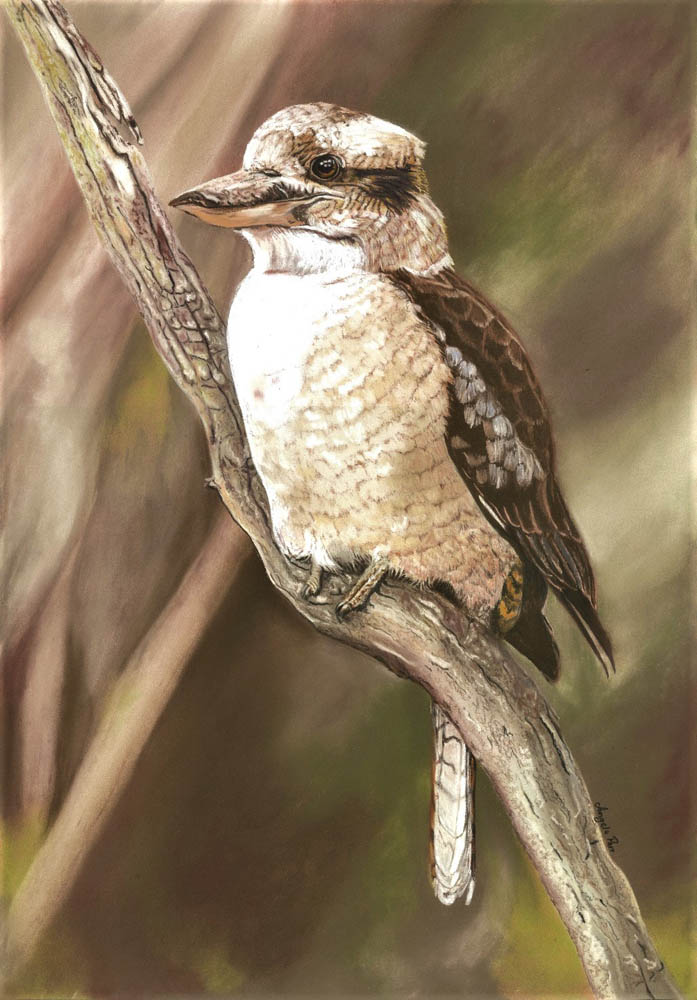Shop
-

Damn! Forgot My Spoon
Pastel on Pastelmat Card ($POA)
The royal spoonbill (Platalea regia) also known as the black-billed spoonbill, occurs in intertidal flats and shallows of fresh and saltwater wetlands in Australia, New Zealand, Indonesia, Papua New Guinea, and the Solomon Islands. It is a wading bird and has long legs for walking through water. Spoonbills are characterized by their spoon-shaped bills, which they use to sweep through the water to catch prey. It eats fish, shellfish, crabs and amphibians, catching its prey by making a side-to-side movement with its bill. Ibises, also have long legs and long necks, but on the other hand have long, curved beaks used for probing in the mud for food. They are however the closest relative spoonbills have. Both Ibis and Spoonbills are excellent indicators of wetland health.
Read moreDamn! Forgot My Spoon
Pastel on Pastelmat Card ($POA)
The royal spoonbill (Platalea regia) also known as the black-billed spoonbill, occurs in intertidal flats and shallows of fresh and saltwater wetlands in Australia, New Zealand, Indonesia, Papua New Guinea, and the Solomon Islands. It is a wading bird and has long legs for walking through water. Spoonbills are characterized by their spoon-shaped bills, which they use to sweep through the water to catch prey. It eats fish, shellfish, crabs and amphibians, catching its prey by making a side-to-side movement with its bill. Ibises, also have long legs and long necks, but on the other hand have long, curved beaks used for probing in the mud for food. They are however the closest relative spoonbills have. Both Ibis and Spoonbills are excellent indicators of wetland health.
Quick View -

Edward
Read morePastel on Pastelmat Card (Sold)
30cm W x 42 cm H
Quick View -

Good Job Girl
$250.00 Add to cartSize 87 cm W x 67 cm H
Limited Edition PrintQuick View -

Good Job Girl
Pastel on Pastelmat Card (Sold)
87cm W x 67 cm H
The Australian Cattle Dog (also known as Blue or Red Heelers) was developed for its ability to drive cattle over long distances in the harsh Australian Outback. It is now considered the best breed in the world for this task. It is a sturdy, muscular, compact dog capable of great speed, agility and strength, when required. It will create a strong bond with its owner, typically resulting in the dog never being too far from the owner’s side. The Australian Cattle Dog can be the friendliest of companions, although as it is quick to respond to the emotions of its owners, it will typically be very protective of them and may defend them without waiting for a command. All these combinations make it an excellent farm dog, working when required and caring for the children, keeping them safe from snakes and other “intruders”. In this image, the quintessential Aussie farmer is not gushy with his dog, just a gentle touch on her head tells her she has done a “good Job”.
Read moreGood Job Girl
Pastel on Pastelmat Card (Sold)
87cm W x 67 cm H
The Australian Cattle Dog (also known as Blue or Red Heelers) was developed for its ability to drive cattle over long distances in the harsh Australian Outback. It is now considered the best breed in the world for this task. It is a sturdy, muscular, compact dog capable of great speed, agility and strength, when required. It will create a strong bond with its owner, typically resulting in the dog never being too far from the owner’s side. The Australian Cattle Dog can be the friendliest of companions, although as it is quick to respond to the emotions of its owners, it will typically be very protective of them and may defend them without waiting for a command. All these combinations make it an excellent farm dog, working when required and caring for the children, keeping them safe from snakes and other “intruders”. In this image, the quintessential Aussie farmer is not gushy with his dog, just a gentle touch on her head tells her she has done a “good Job”.
Quick View -
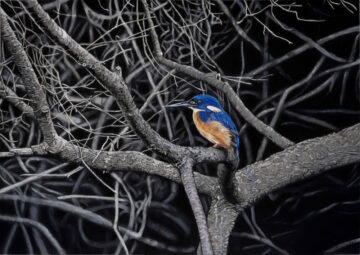
In the Forest Deep and Dark
Pastel on Pastelmat Board ($POA)
Image size 47cm h x 56 cm w
Framed 83 cm h x 65 cm w
The Azure Kingfisher is found across northern and eastern Australia, almost always above water. It patrols up and down waterways and rivers from perch to perch flying very fast, and only a few meters off the water, typically making a loud high pitched “seeeeeeeep” call. They are very defensive of their breeding territory and form monogamous pairs. Their nests are hidden away at the end of a burrow, dug out of soil in riverbanks. Both parents incubate and feed the chicks. This pastel artwork captures an Azure Kingfisher in a fragile eco-system, a deep and dark mangrove forest. My artwork has contrasted a monochrome background with the bright blues of the bird, thereby focusing on it and the purity of its environment, hoping to elicit in the viewer an urgent need to protect our critical coastal habitats for future generations.Read moreIn the Forest Deep and Dark
Pastel on Pastelmat Board ($POA)
Image size 47cm h x 56 cm w
Framed 83 cm h x 65 cm w
The Azure Kingfisher is found across northern and eastern Australia, almost always above water. It patrols up and down waterways and rivers from perch to perch flying very fast, and only a few meters off the water, typically making a loud high pitched “seeeeeeeep” call. They are very defensive of their breeding territory and form monogamous pairs. Their nests are hidden away at the end of a burrow, dug out of soil in riverbanks. Both parents incubate and feed the chicks. This pastel artwork captures an Azure Kingfisher in a fragile eco-system, a deep and dark mangrove forest. My artwork has contrasted a monochrome background with the bright blues of the bird, thereby focusing on it and the purity of its environment, hoping to elicit in the viewer an urgent need to protect our critical coastal habitats for future generations.Quick View -

In the Forest Deep and Dark
$200.00 Add to cartSize 56 cm W x 47 cm H
Limited Edition PrintQuick View -

Jet
Read morePastels on Pastelmat Board (Sold)
Quick View -

Kovu
Read morePastels (Sold)
Size 64cm H x 50cm W
Quick View -

Pickles
Read morePastels on Pastelmat Board (Sold)
Quick View -

Pixie
Read morePastels (Sold)
Size 24cm H x 18cm W
Quick View -
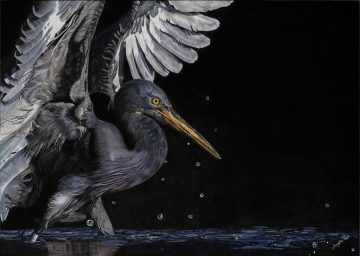
Reef Raider
Pastel on Pastelmat Board (Sold)
Image size 42 cm H x 60 cm W.
Framed 61 cm H x 78 cm WFlat Rock is exactly as it sounds, a large flat rocky outcrop between two beaches in the Ballina Shire. It is a haven for seabirds, both local and migratory, and they know they are safe there. This Pacific Reef Egret (also known as Eastern Reef Egret, and Pacific Reef Heron) was busy fishing in the early morning, wading through one of the many shallow pools.
Having lived in this area since 1982, I often walk these beaches enjoying the beautiful sights here. I just love the drama in this image and hope my artwork has conveyed this.Read moreReef Raider
Pastel on Pastelmat Board (Sold)
Image size 42 cm H x 60 cm W.
Framed 61 cm H x 78 cm WFlat Rock is exactly as it sounds, a large flat rocky outcrop between two beaches in the Ballina Shire. It is a haven for seabirds, both local and migratory, and they know they are safe there. This Pacific Reef Egret (also known as Eastern Reef Egret, and Pacific Reef Heron) was busy fishing in the early morning, wading through one of the many shallow pools.
Having lived in this area since 1982, I often walk these beaches enjoying the beautiful sights here. I just love the drama in this image and hope my artwork has conveyed this.Quick View -

Reef Raider
$250.00 Add to cartSize 87 cm W x 67 cm H
Limited Edition PrintQuick View -

Salt
Read morePastels on Pastelmat Board (Sold)
Quick View -

Scarlet Honeyeater
Pastel on Pastelmat Board ($POA)
Image size 46 cm H x 66 cm W
The tiny Scarlet Honeyeater’s range extends along the east coast of Australia. As with most Australian birds, the male is the showier of the two, with brilliant red coloration on the face and back. The female, in contrast, is pale brown-grey.
This is no doubt to protect her, and her offspring in the nest, by being less obvious for predators. My artwork is aimed to highlight her petite beauty, as she props within a flourish of red grevillea, in the Northern Rivers area of NSW, awaiting a male to enthusiastically call out to her.Read moreScarlet Honeyeater
Pastel on Pastelmat Board ($POA)
Image size 46 cm H x 66 cm W
The tiny Scarlet Honeyeater’s range extends along the east coast of Australia. As with most Australian birds, the male is the showier of the two, with brilliant red coloration on the face and back. The female, in contrast, is pale brown-grey.
This is no doubt to protect her, and her offspring in the nest, by being less obvious for predators. My artwork is aimed to highlight her petite beauty, as she props within a flourish of red grevillea, in the Northern Rivers area of NSW, awaiting a male to enthusiastically call out to her.Quick View -

She Contemplates
Pastel on Pastelmat Board ($POA)
Image size 45cm h x 58 cm w
Framed 63 cm h x 76 cm w
Kookaburras are the unique and much-loved sound of the Australian bush. Despite being “boofy- headed”, they are still considered very handsome birds with an intelligent eye. They have a strong beak and a compact body covered in a beautiful array of whites, browns, and blacks. Who wouldn’t love them? This female was captured in the failing light just outside Lismore, northern NSW, presumably contemplating her next meal. Her peaceful demeanour lent itself to a serene portrait using dramatic lighting for highlighting purposes.Read moreShe Contemplates
Pastel on Pastelmat Board ($POA)
Image size 45cm h x 58 cm w
Framed 63 cm h x 76 cm w
Kookaburras are the unique and much-loved sound of the Australian bush. Despite being “boofy- headed”, they are still considered very handsome birds with an intelligent eye. They have a strong beak and a compact body covered in a beautiful array of whites, browns, and blacks. Who wouldn’t love them? This female was captured in the failing light just outside Lismore, northern NSW, presumably contemplating her next meal. Her peaceful demeanour lent itself to a serene portrait using dramatic lighting for highlighting purposes.Quick View -

She Contemplates
$200.00 Add to cartSize 58 cm W x 44cm H
Limited Edition PrintQuick View -

The Reds
Pastel on Pastelmat Board ($POA)
Image size 80 cm h x 60 cm w
Framed 100 cm h x 78 cm w
I recently spent time in Western Australia where these stunning Forest Red Tails reside. Sadly they are critically endangered due to losses of native habitat, car strikes, nesting competition, animal attacks, and poaching.
They mate for life, sometimes over 50 years, but as they breed slowly, just one young every second year, increasing the species’ numbers has proven difficult.
Their distinctive screech gave them their Noongar name, the Karrak, and is also old bush-lore indicating rain is coming. To see them fly overhead is an absolute privilege, and I hope to have paid homage to their beauty in my artwork.Read moreThe Reds
Pastel on Pastelmat Board ($POA)
Image size 80 cm h x 60 cm w
Framed 100 cm h x 78 cm w
I recently spent time in Western Australia where these stunning Forest Red Tails reside. Sadly they are critically endangered due to losses of native habitat, car strikes, nesting competition, animal attacks, and poaching.
They mate for life, sometimes over 50 years, but as they breed slowly, just one young every second year, increasing the species’ numbers has proven difficult.
Their distinctive screech gave them their Noongar name, the Karrak, and is also old bush-lore indicating rain is coming. To see them fly overhead is an absolute privilege, and I hope to have paid homage to their beauty in my artwork.Quick View -

The Reds
$350.00 Add to cartSize 60 cm W x 80 cm H
Limited Edition PrintQuick View -

My Favourite Colour is Blue
Pastels ($POA)
30cm H x 45cm W
The Azure kingfisher is a tiny, colourful and highly elusive aquatic kingfisher, usually found above or around the edges of most waterways that have low, overhanging branches.
It patrols up and down waterways and rivers from perch to perch flying very fast, and only a few meters off the water, typically making a loud high pitched “seeeeeeeep” call.
It has a long black beak and a whitish rear eye spot. This bird gets its name from its beautiful colouring, being dark glossy blue, its underside an orange-rufous; its legs and feet red. Males and females have very similar appearance and juveniles are less vibrant in colour.
These birds are generally sedentary, although they can perform some seasonal migration.
You might see this shy bird skimming along the surface of creeks and billabongs as it hunts for fish before ducking back into the vegetation.Read moreMy Favourite Colour is Blue
Pastels ($POA)
30cm H x 45cm W
The Azure kingfisher is a tiny, colourful and highly elusive aquatic kingfisher, usually found above or around the edges of most waterways that have low, overhanging branches.
It patrols up and down waterways and rivers from perch to perch flying very fast, and only a few meters off the water, typically making a loud high pitched “seeeeeeeep” call.
It has a long black beak and a whitish rear eye spot. This bird gets its name from its beautiful colouring, being dark glossy blue, its underside an orange-rufous; its legs and feet red. Males and females have very similar appearance and juveniles are less vibrant in colour.
These birds are generally sedentary, although they can perform some seasonal migration.
You might see this shy bird skimming along the surface of creeks and billabongs as it hunts for fish before ducking back into the vegetation.Quick View -
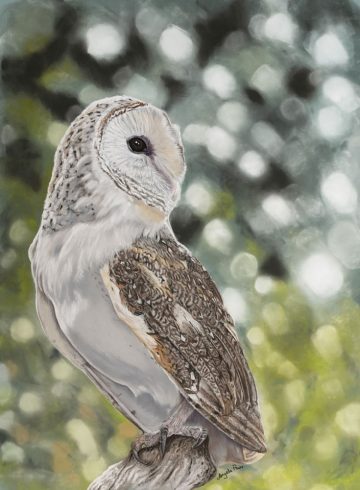
Socrates
Pastels ($POA)
60 cm H x 48 cm W
Barn owls live alone or in pairs and are excellent hunters, catching their prey in complete darkness, using super-sensitive hearing, and silent flight.
Being nocturnal, they roost quietly by day in unseen places like tree hollows, thickly foliaged trees, caves and rock crevices, buildings and even wells. As Australia is one of the world’s worst offenders when it comes to land clearing, with a projected 3 million hectares of untouched forest to be lost by 2030, one of the biggest threats to Australian owls is loss of habitat. Our owls rely on hollow-bearing trees, often hundreds of years old, for breeding.
As owls are natural predators of rodents, Rat Poison is fast becoming the biggest killers of owls, due to secondary killings. Owls also fall victim to vehicle strikes as they disperse in search of food when local prey populations begin to thin out, or drought conditions affect inland Australia.Read moreSocrates
Pastels ($POA)
60 cm H x 48 cm W
Barn owls live alone or in pairs and are excellent hunters, catching their prey in complete darkness, using super-sensitive hearing, and silent flight.
Being nocturnal, they roost quietly by day in unseen places like tree hollows, thickly foliaged trees, caves and rock crevices, buildings and even wells. As Australia is one of the world’s worst offenders when it comes to land clearing, with a projected 3 million hectares of untouched forest to be lost by 2030, one of the biggest threats to Australian owls is loss of habitat. Our owls rely on hollow-bearing trees, often hundreds of years old, for breeding.
As owls are natural predators of rodents, Rat Poison is fast becoming the biggest killers of owls, due to secondary killings. Owls also fall victim to vehicle strikes as they disperse in search of food when local prey populations begin to thin out, or drought conditions affect inland Australia.Quick View -

Back Off! She’s Mine!
Acrylic on Canvas (sold)
150 cm W x 180 cm H
Black cockatoos are my absolute favourite birds, and these three “yellow-tails” were a commission for a local family who had a large wall which needed a stunningly large artwork to feature on it.
They also have a beautiful flowering Corymbia Calophylla tree in their yard, which they requested to be incorporated into the composition. As it turns out they have two sons and a daughter, and by mere coincidence, I painted two male cockatoos (they have the pink rimmed eyes) and one female (grey rimmed eyes). My clients now feel the cockatoos represent their own three “golden” children. One could say it was a very successful commission for all involved. Limited Edition Prints are available, and as always a percentage of sales goes to the Byron Bay Wildlife Hospital.Read moreBack Off! She’s Mine!
Acrylic on Canvas (sold)
150 cm W x 180 cm H
Black cockatoos are my absolute favourite birds, and these three “yellow-tails” were a commission for a local family who had a large wall which needed a stunningly large artwork to feature on it.
They also have a beautiful flowering Corymbia Calophylla tree in their yard, which they requested to be incorporated into the composition. As it turns out they have two sons and a daughter, and by mere coincidence, I painted two male cockatoos (they have the pink rimmed eyes) and one female (grey rimmed eyes). My clients now feel the cockatoos represent their own three “golden” children. One could say it was a very successful commission for all involved. Limited Edition Prints are available, and as always a percentage of sales goes to the Byron Bay Wildlife Hospital.Quick View -

Back Off! She’s Mine!
$350.00 Add to cart750mm W x 900 mm H
Limited Edition PrintQuick View -

Girl Gang
Pastel on Pastelmat (Sold)
89 cm W x 63 cm H
Galahs (Eolophus roseicapilla) are one of the most abundant and familiar of the Australian parrots, occurring over most of the country, including some offshore islands. Galahs have a bouncing acrobatic flight, but spend much of the day sheltering from heat in the foliage of trees and shrubs. Huge noisy flocks of birds congregate and roost together at night. They are affectionate and friendly birds, with pairs mating for life. Female Galahs have red or pink eyes (the males have brown or black), so these are girls obviously hanging together for a good giggle.
Read moreGirl Gang
Pastel on Pastelmat (Sold)
89 cm W x 63 cm H
Galahs (Eolophus roseicapilla) are one of the most abundant and familiar of the Australian parrots, occurring over most of the country, including some offshore islands. Galahs have a bouncing acrobatic flight, but spend much of the day sheltering from heat in the foliage of trees and shrubs. Huge noisy flocks of birds congregate and roost together at night. They are affectionate and friendly birds, with pairs mating for life. Female Galahs have red or pink eyes (the males have brown or black), so these are girls obviously hanging together for a good giggle.
Quick View -

You’re Such a Show Off
Pastel on Pastelmat Board (sold)
94 cm W x 64 cm H
Black cockatoos are the biggest parrots in Australia, and these Yellow-Tails have been painted life size to illustrate just how large they really are. The male (pink eye rim) is a big show off, usually dancing around during breeding season to impress his mate, bopping his head like a rock star, and fluffing up his crest. But they are also very intelligent and loving, often bringing their mate gifts of food, singing to her and preening her feathers to show his affection. The female is less than impressed, often giving him a sharp peck to bring him into line. Hence my title. They mate for life, which can be over 50 years, but sadly they breed slowly, just two eggs, of which only one survives. The chick will stay with its parents for six months before becoming independent. The adult pair will remain together for life, caring tenderly for one another, even after reproductive age has ceased. Their distinctive screech is old bush lore indicating rain is coming, and I always love seeing their huge flocks fly over our property, screaming raucously. They are one of my favourite birds.Read moreYou’re Such a Show Off
Pastel on Pastelmat Board (sold)
94 cm W x 64 cm H
Black cockatoos are the biggest parrots in Australia, and these Yellow-Tails have been painted life size to illustrate just how large they really are. The male (pink eye rim) is a big show off, usually dancing around during breeding season to impress his mate, bopping his head like a rock star, and fluffing up his crest. But they are also very intelligent and loving, often bringing their mate gifts of food, singing to her and preening her feathers to show his affection. The female is less than impressed, often giving him a sharp peck to bring him into line. Hence my title. They mate for life, which can be over 50 years, but sadly they breed slowly, just two eggs, of which only one survives. The chick will stay with its parents for six months before becoming independent. The adult pair will remain together for life, caring tenderly for one another, even after reproductive age has ceased. Their distinctive screech is old bush lore indicating rain is coming, and I always love seeing their huge flocks fly over our property, screaming raucously. They are one of my favourite birds.Quick View -

You’re Such a Show Off
$350.00 Add to cartQuick View -

Jabiru Dreaming
$150.00 Add to cartQuick View -

Protecting Her Young
$300.00 Add to cartQuick View -

Rainbows Take Flight
$350.00 Add to cartQuick View -

The Bow Wave
$200.00 Add to cartQuick View -

The Observer
$200.00 Add to cartQuick View -
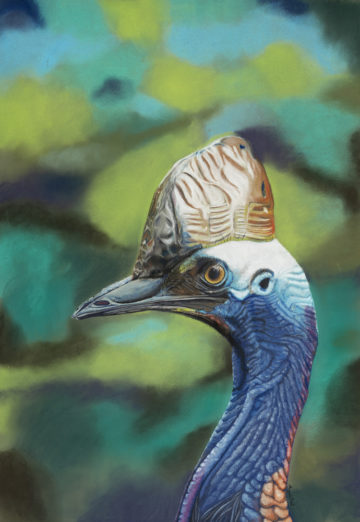
Wrinkles
$200.00 Add to cartQuick View -

African Animal 5 Art Cards
$25.0012 cm x 17 cm
5 cards, 5 designs
*All come with envelopes and a plastic sleeve coverAdd to cartAfrican Animal 5 Art Cards
$25.0012 cm x 17 cm
5 cards, 5 designs
*All come with envelopes and a plastic sleeve coverQuick View -

Australian Animal 5 Art Cards
$25.0012 cm x 17 cm
5 cards, 5 designs
*All come with envelopes and a plastic sleeve coverAdd to cartAustralian Animal 5 Art Cards
$25.0012 cm x 17 cm
5 cards, 5 designs
*All come with envelopes and a plastic sleeve coverQuick View -

Australian Bird 10 Art Cards
$50.0012 cm x 17 cm
10 cards, 10 designs
*All come with envelopes and a plastic sleeve coverAdd to cartAustralian Bird 10 Art Cards
$50.0012 cm x 17 cm
10 cards, 10 designs
*All come with envelopes and a plastic sleeve coverQuick View -

Australian Bird 10 Square Art Cards
$50.0014.5 cm x 14.5 cm
10 cards, 10 designs
*All come with envelopes and a plastic sleeve coverAdd to cartAustralian Bird 10 Square Art Cards
$50.0014.5 cm x 14.5 cm
10 cards, 10 designs
*All come with envelopes and a plastic sleeve coverQuick View -

Australian Bird 5 Art Cards
$25.0012 cm x 17 cm
5 cards, 5 designs
*All come with envelopes and a plastic sleeve coverAdd to cartAustralian Bird 5 Art Cards
$25.0012 cm x 17 cm
5 cards, 5 designs
*All come with envelopes and a plastic sleeve coverQuick View -

Australian Bird 5 Square Art Cards
$25.0014.5 cm x 14.5 cm
5 cards, 5 designs
*All come with envelopes and a plastic sleeve coverAdd to cartAustralian Bird 5 Square Art Cards
$25.0014.5 cm x 14.5 cm
5 cards, 5 designs
*All come with envelopes and a plastic sleeve coverQuick View -
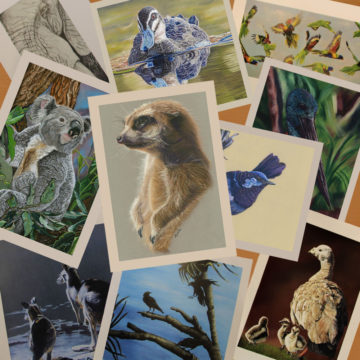
Random Mix 10 Cards
$50.00 Add to cart10 cards, 10 designs
*All come with envelopes and a plastic sleeve cover
Quick View -

Random Mix 5 Cards
$25.00 Add to cart5 cards, 5 designs
*All come with envelopes and a plastic sleeve cover
Quick View -

Protecting Her Young
Pastel on Pastelmat (sold)
51 cm W x 71 cm H
An early morning drive on Kangaroo Island revealed Cape Barron Geese (Cereopsis novaehollandiae) grazing in the grassy clearing. A month later half of the island was burning, and I was concerned for this little flock. Cape Barron Geese were almost hunted to extinction in the 1900’s but numbers eventually restored to 20,000 on Australia’s southern islands. They are monogamous, bonding for life, and aggressively defend their clutches of 4-5 eggs. They are one of the world’s rarest geese. In my artwork I highlight their beautiful plumage, the adult’s defensive position over the vulnerable chicks, and hint at the imminent danger of fire.Read moreProtecting Her Young
Pastel on Pastelmat (sold)
51 cm W x 71 cm H
An early morning drive on Kangaroo Island revealed Cape Barron Geese (Cereopsis novaehollandiae) grazing in the grassy clearing. A month later half of the island was burning, and I was concerned for this little flock. Cape Barron Geese were almost hunted to extinction in the 1900’s but numbers eventually restored to 20,000 on Australia’s southern islands. They are monogamous, bonding for life, and aggressively defend their clutches of 4-5 eggs. They are one of the world’s rarest geese. In my artwork I highlight their beautiful plumage, the adult’s defensive position over the vulnerable chicks, and hint at the imminent danger of fire.Quick View -

A Keen Eye
Pastel on Pastelmat (Sold)
51 cm W x 67 cm H
The Laughing Kookaburra (Dacelo novaeguineae) is arguably the best-known and most loved bird of Australia with its highly distinctive raucous “laugh”. The loud ‘koo-koo-koo-koo-koo-kaa-kaa-kaa’ is however not really the kookaburra laughing but actually a territorial call to warn other birds to stay away. Laughing Kookaburras feed mostly on insects, worms and crustaceans, although small snakes, mammals, frogs and birds may also be eaten. Prey is espied and then seized by pouncing from a suitable perch, as shown in my artwork. Small prey is eaten whole, but larger prey is killed by bashing it against the ground or tree branch.Read moreA Keen Eye
Pastel on Pastelmat (Sold)
51 cm W x 67 cm H
The Laughing Kookaburra (Dacelo novaeguineae) is arguably the best-known and most loved bird of Australia with its highly distinctive raucous “laugh”. The loud ‘koo-koo-koo-koo-koo-kaa-kaa-kaa’ is however not really the kookaburra laughing but actually a territorial call to warn other birds to stay away. Laughing Kookaburras feed mostly on insects, worms and crustaceans, although small snakes, mammals, frogs and birds may also be eaten. Prey is espied and then seized by pouncing from a suitable perch, as shown in my artwork. Small prey is eaten whole, but larger prey is killed by bashing it against the ground or tree branch.Quick View -

The Bow Wave
Pastel on Pastelmat (Sold)
45 cm W x 45 cm H
Sunset on Lake Ainsworth at Lennox Head, and this Pacific Black Duck (Anas superciliosa) was hunting a final meal for the day. Their diet is mainly vegetarian, supplemented by small molluscs, crustaceans, and insects, not bread, which well-meaning but misinformed people often feed them. Due to their “commonness” ducks are often overlooked as subjects to paint, although they have obvious beauty. They are at risk from habitat loss and despite the strong evidence of the extreme suffering involved, four Australian states still allow recreational duck hunting. My artwork aims to draw attention to these ducks, becoming a conversation starter for their protection.Read moreThe Bow Wave
Pastel on Pastelmat (Sold)
45 cm W x 45 cm H
Sunset on Lake Ainsworth at Lennox Head, and this Pacific Black Duck (Anas superciliosa) was hunting a final meal for the day. Their diet is mainly vegetarian, supplemented by small molluscs, crustaceans, and insects, not bread, which well-meaning but misinformed people often feed them. Due to their “commonness” ducks are often overlooked as subjects to paint, although they have obvious beauty. They are at risk from habitat loss and despite the strong evidence of the extreme suffering involved, four Australian states still allow recreational duck hunting. My artwork aims to draw attention to these ducks, becoming a conversation starter for their protection.Quick View





